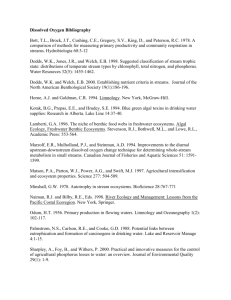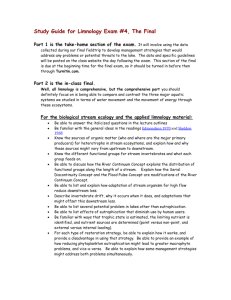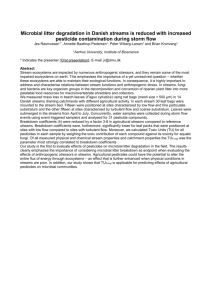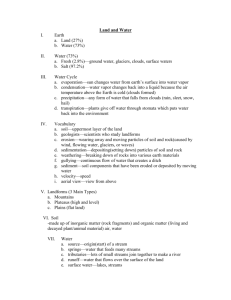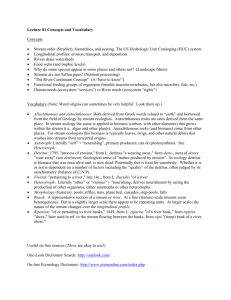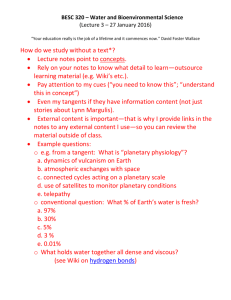Appendix A - Springer Static Content Server
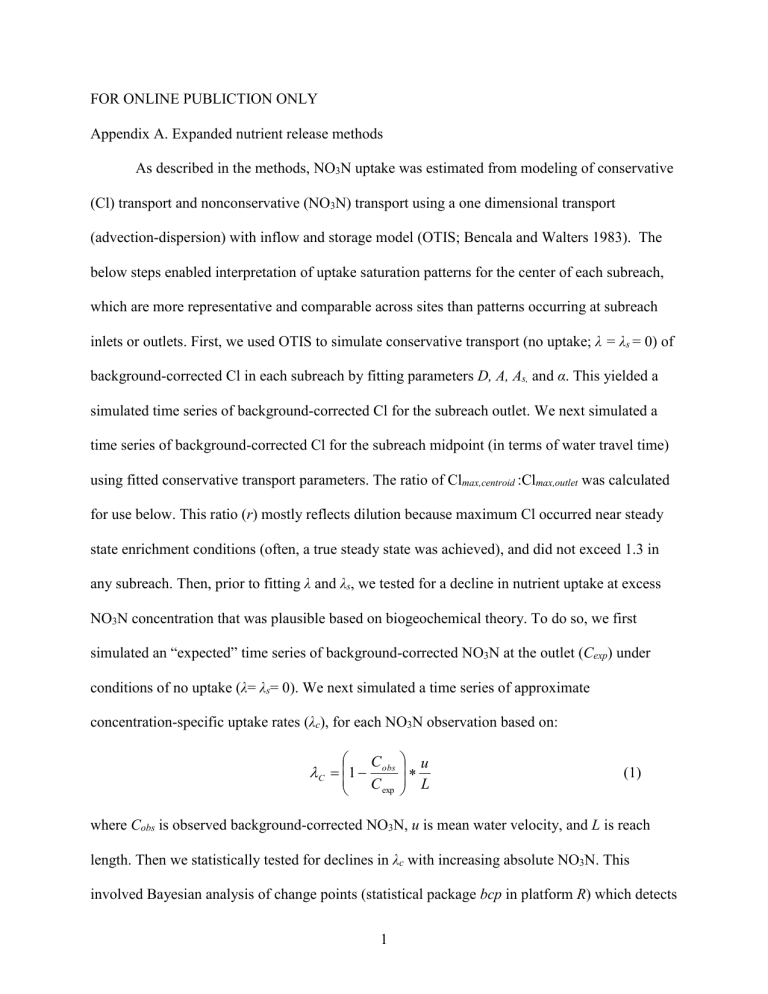
FOR ONLINE PUBLICTION ONLY
Appendix A. Expanded nutrient release methods
As described in the methods, NO
3
N uptake was estimated from modeling of conservative
(Cl) transport and nonconservative (NO
3
N) transport using a one dimensional transport
(advection-dispersion) with inflow and storage model (OTIS; Bencala and Walters 1983). The below steps enabled interpretation of uptake saturation patterns for the center of each subreach, which are more representative and comparable across sites than patterns occurring at subreach inlets or outlets.
First, we used OTIS to simulate conservative transport (no uptake;
λ = λ s
= 0) of background-corrected Cl in each subreach by fitting parameters D, A, A s,
and
α
. This yielded a simulated time series of background-corrected Cl for the subreach outlet. We next simulated a time series of background-corrected Cl for the subreach midpoint (in terms of water travel time) using fitted conservative transport parameters. The ratio of Cl max,centroid
:Cl max,outlet
was calculated for use below. This ratio ( r ) mostly reflects dilution because maximum Cl occurred near steady state enrichment conditions (often, a true steady state was achieved), and did not exceed 1.3 in any subreach. Then, prior to fitting
λ
and
λ s
, we tested for a decline in nutrient uptake at excess
NO
3
N concentration that was plausible based on biogeochemical theory. To do so, we first simulated an “expected” time series of background-corrected NO
3
N at the outlet ( C exp
) under conditions of no uptake (
λ
=
λ s
= 0). We next simulated a time series of approximate concentration-specific uptake rates (
λ c
), for each NO
3
N observation based on:
C
1
C obs
C exp
u
L
(1) where C obs
is observed background-corrected NO
3
N, u is mean water velocity, and L is reach length. Then we statistically tested for declines in
λ c
with increasing absolute NO
3
N. This involved Bayesian analysis of change points (statistical package bcp in platform R ) which detects
1
a change in mean uptake (
C
) over the range of C obs
. Results from Bayesian analysis of change points were consistent with patterns visible by eye: in some cases, no decline in
λ c
was observed at excess NO
3
N, whereas in others, λ c
declined above an enrichment threshold ( C p
). Note that there was not a substantial change in the
λ c
~ C obs
pattern when restricted to C obs
occurring at or near steady state enrichment, so we used the entire time series of λ c
~ C obs
in this step. This approach enabled detection of partial saturating patterns that, in the absence of data at very high nutrient enrichment, cannot always be parameterized effectively using conventional saturation approaches (for example, Michaelis-Menten). Of 24
λ c time series, 12 had a detectable change consistent with partial saturation, whereas 12 had no evidence of change. We then calculated
C thresh
, a reach-centered enrichment threshold at which λ c
declines, based on the exponential decay function:
C thresh
C cp
1
* e
C
50
* r + C bg
(2) where C cp
is the threshold NO
3
N concentration determined from change point analysis,
is the
C mean of
λ c
corresponding to less than C cp
(an approximation of uptake rate, used for this step only),
τ
50
(T) is half of mean water residence time
L
2 u
for the reach, r is a dilution-dispersion correction from above, and C bg
is background NO
3
N. Mean C thresh
was 54 µg L
-1
(± 21, 1 s.d.).
We next isolated unsaturated portions of each outlet NO
3
N time series based on the common criterion of less than 54 µg L
-1
absolute NO
3
N. To do this for each subreach, we calculated C test by substituting each individual value of C obs in place C cp
given by equation 2. C obs
values resulting in C test
greater than 54 µg L
-1
were then discarded, yielding the time series C use
which always had at least 12 values following initial arrival of experimental NO
3
N. The observation of under-saturated NO
3
N kinetics below this enrichment level is supported by previous stream
2
literature; O’Brien and Dodds (2010) reported a Michaelis-Menten half-saturation coefficient
( K s
) of 67 µg L -1 for NO
3
N uptake in prairie streams. Grimm and Fisher (1986) reported a threshold of 55 µg L -1
NO
3
N for N limitation of stream periphyton growth. Finally, we estimated NO
3
N uptake parameters (
λ
and
λ s
) using the entire time series of backgroundcorrected NO
3
N for the inlet, and C use
for the outlet.
Literature sources for transient storage parameter data sets, used for modeling of P s
in
Figure 5, are shown in Table A.
3
Table A. Literature Sources for Transient Storage Parameter Data Sets Used for Modeling of P s
in Figure 5
Reference System(s)
Argerich and others (2008) Riera de Santa Fe, Spain (SP)
Bencala (1984) Little Lost Man Cr, California (CA)
Bencala and Walters (1983) Uvas Cr, CA
Bencala and others (1990) Snake R, Colorado (CO)
Broshears and others (1993) St. Kevin Gulch, CO
Broshears and others (1996) St. Kevin Gulch, CO
Butturini and Sabater (1999) Riera Major, SP
Chapra and Wilcock (2000) Paiko R*, New Zealand (NZ)
Cheong and Seo (2003) Amite R, Louisiana (LA); Antietam Cr, Maryland (MD); Bayou Ancoco, LA; Bayou Bartholomew,
LA; Bear Cr, CO; Chatahoochee R, Georgia (GA); Clinch R, Virginia (VA); Coachechella Canal,
CA; Comite R, LA; Conococheague Cr, MD; Copper Cr, VA; Difficult Run, VA; Green and
Duwamish R, Washington (WA); Little Pincy Cr, MD; Monocacy R, MD; Missouri R (MT);
Mississippi R, LA; Powell R, Tennessee (TN); Red R, LA; Sabin R, Texas (TX); Salt Cr, Nebraska
(NE); Tangipahoe R, LA; Tickfau R, LA
D’Angelo and others (1993) streams of Coweeta Hydrologic Laboratory, Virginia (VA)
Fernald and others (2001) Willamette R, Oregon (OR)
Ge and Boufadel (2006) Indian Cr, Pennsylvania (PA)
Gooseff and others (2004) Green Cr, Antarctica
Gücker and Pusch (2006) Denmitzer Mill Br, Germany (GE); Erpe, GE
Hall and others (2002) streams of Hubbard Brook Experimental Forest, New Hampshire (NH)
Hart and others (1999) West Fork Walker Branch, TN
Harvey and others (1996) St. Kevin Gulch, CO
Harvey and others (2003) Pinal Cr, Arizona (AZ)
Harvey and others (2005) Shark River Slough, Florida (FL)
*Wetland site, per description of the authors. These sites all had mean water velocity less than 0.06 m s
-1
.
4
Table A (continued).
Reference
Keefe and others (2004)
System(s) constructed wetlands* near Phoenix, AZ
Kimball and others (1994) St. Kevin Gulch
Martí and others (1997) Sycamore Cr, AZ
Martinez and Wise (2003) Orlando Easterly Wetland*, FL
McKnight and others (2002) Snake R, CO
McKnight and others (2004) Green Cr, Antarctica
Morrice and others (1997) Aspen Cr, New Mexico (NM); Rio Calaveras, NM; Galina Cr, NM
Mulholland and others High White Cr, TN; West Fork Walker Branch, TN
(1997)
Powers and others (2009) streams of southern Wisconsin (WI)
Ruehl and others (2006) Pajaro R, CA
Stofleth and others (2008) Little Topshaw Cr, Mississippi (MS); Goodwin Cr*, MS
Webster and others (2003) Ball Cr, North Carolina (NC); Bear Br, NH; E1 outlet, Alaska (AK); Eagle Cr, MI; East Fork Little
Miami R, Ohio (OH); Gallina Cr, NM; Kings Cr, Kansas (KS); Mack Cr, OR; Quebrada Bisley,
Valett and others (1997)
Puerto Rico; Sycamore Cr, AZ; West Fork Walker Branch, TN
Aspen Cr (NM); Rio Calaveras (NM); Gallina Cr (NM)
Wondzell and others (2006) streams of Andrews Experimental Forest, OR
Systems are located in USA unless otherwise noted. Abbreviations: R=river, Cr= creek, Br= brook.
*Wetland site, per description of the authors. These sites all had mean water velocity less than 0.06 m s
-1
.
5
References
Argerich A, Martí E, Sabater F, Ribot M, von Schiller D, Riera JL. 2008. Combined effects of leaf litter inputs and a flood on nutrient retention in a Mediterranean mountain stream during fall. Limnology and Oceanography 53(2):631-641.
Bencala KE. 1984. Interactions of solutes and streambed sediment 2. A dynamic analysis of coupled hydrologic and chemical processes that determine solute transport. Water
Resources Research 20(12):1804-1814.
Bencala KE, McKnight DM, Zellweger GW. 1990. Characterization of transport in an acidic and metal-rich mountain stream based on a lithium tracer injection and simulations of transient storage. Water Resources Research 26(5):989-1000.
Bencala KE, Rathbun RE, Jackman AP, Kennedy VC, Zellweger GW, Avanzino RJ. 1983.
Rhodamine WT dye losses in a mountain stream environment. Water Resources Bulletin
19(6):943-950.
Bencala KE, Walters RA. 1983. Simulation of solute transport in a mountain pool-and-riffle stream - a transient storage model. Water Resources Research 19(3):718-724.
Broshears RE, Bencala KE, Kimball BA, McKnight DM. 1993. Tracer-dilution experiments and solute-transport simulations for a mountain stream, Saint Kevin Gulch, Colorado. US
Geological Survey Water-Resources Investigation Report 92-4081. Denver, Colorado.
Broshears RE, Runkel RL, Kimball BA, McKnight DM, Bencala KE. 1996. Reactive solute transport in an acidic stream: Experimental pH increase and simulation of controls on pH, aluminum, and iron. Environmental Science & Technology 30(10):3016-3024.
6
Butturini A, Sabater F. 1999. Importance of transient storage zones for ammonium and phosphate retention in a sandy-bottom Mediterranean stream. Freshwater Biology
41(3):593-603.
Chapra SC, Wilcock RJ. 2000. Transient storage and gas transfer in lowland stream. Journal of
Environmental Engineering-ASCE 126(8):708-712.
Cheong TS, Seo IW. 2003. Parameter estimation of the transient storage model by a routing method for river mixing processes. Water Resources Research 39(4):1074.
Dangelo DJ, Webster JR, Gregory SV, Meyer JL. 1993. Transient storage in Appalachian and
Cascade mountain streams as related to hydraulic characteristics. Journal of the North
American Benthological Society 12(3):223-235.
Demars BOL. 2008. Whole-stream phosphorus cycling: Testing methods to assess the effect of saturation of sorption capacity on nutrient uptake length measurements. Water Research
42(10-11):2507-2516.
Earl SR, Valett HM, Webster JR. 2006. Nitrogen saturation in stream ecosystems. Ecology
87(12):3140-3151.
Earl SR, Valett HM, Webster JR. 2007. Nitrogen spiraling in streams: Comparisons between stable isotope tracer and nutrient addition experiments. Limnology and Oceanography
52(4):1718-1723.
Fernald AG, Wigington PJ, Landers DH. 2001. Transient storage and hyporheic flow along the
Willamette River, Oregon: Field measurements and model estimates. Water Resources
Research 37(6):1681-1694.
Ge Y, Boufadel MC. 2006. Solute transport in multiple-reach experiments: Evaluation of parameters and reliability of prediction. Journal of Hydrology 323(1-4):106-119.
7
Gooseff MN, McKnight DM, Runkel RL, Duff JH. 2004. Denitrification and hydrologic transient storage in a glacial meltwater stream, McMurdo Dry Valleys, Antarctica.
Limnology and Oceanography 49(5):1884-1895.
Grimm NB, Fisher SG. 1986. Nitrogen limitation in a Sonoran Desert stream. Journal of the
North American Benthological Society 5(1):2-15.
Gucker B, Pusch MT. 2006. Regulation of nutrient uptake in eutrophic lowland streams.
Limnology and Oceanography 51(3):1443-1453.
Hall RO, Bernhardt ES, Likens GE. 2002. Relating nutrient uptake with transient storage in forested mountain streams. Limnology and Oceanography 47(1):255-265.
Hart DR, Mulholland PJ, Marzolf ER, DeAngelis DL, Hendricks SP. 1999. Relationships between hydraulic parameters in a small stream under varying flow and seasonal conditions. Hydrological Processes 13(10):1497-1510.
Harvey JW, Conklin MH, Koelsch RS. 2003. Predicting changes in hydrologic retention in an evolving semi-arid alluvial stream. Advances in Water Resources 26(9):939-950.
Harvey JW, Saiers JE, Newlin JT. 2005. Solute transport and storage mechanisms in wetlands of the Everglades, south Florida. Water Resources Research 41(5):W05009.
Harvey JW, Wagner BJ, Bencala KE. 1996. Evaluating the reliability of the stream tracer approach to characterize stream-subsurface water exchange. Water Resources Research
32(8):2441-2451.
Keefe SH, Barber LB, Runkel RL, Ryan JN, McKnight DM, Wass RD. 2004. Conservative and reactive solute transport in constructed wetlands. Water Resources Research 40(1).
8
Kimball BA, Broshears RE, Bencala KE, Mcknight DM. 1994. Coupling of hydrologic transport and chemical-reactions in a stream affected by acid-mine drainage. Environmental
Science & Technology 28(12):2065-2073.
Martí E, Grimm NB, Fisher SG. 1997. Pre- and post-flood retention efficiency of nitrogen in a
Sonoran Desert stream. Journal of the North American Benthological Society 16(4):805-
819.
Martinez CJ, Wise WR. 2003. Hydraulic analysis of Orlando Easterly Wetland. Journal of
Environmental Engineering-ASCE 129(6):553-560.
McKnight DM, Hornberger GM, Bencala KE, Boyer EW. 2002. In-stream sorption of fulvic acid in an acidic stream: A stream-scale transport experiment. Water Resources Research
38(1):1005.
McKnight DM, Runkel RL, Tate CM, Duff JH, Moorhead DL. 2004. Inorganic N and P dynamics of Antarctic glacial meltwater streams as controlled by hyporheic exchange and benthic autotrophic communities. Journal of the North American Benthological Society
23(2):171-188.
Morrice JA, Valett HM, Dahm CN, Campana ME. 1997. Alluvial characteristics, groundwatersurface water exchange and hydrological retention in headwater streams. Hydrological
Processes 11(3):253-267.
Mulholland PJ, Marzolf ER, Webster JR, Hart DR, Hendricks SP. 1997. Evidence that hyporheic zones increase heterotrophic metabolism and phosphorus uptake in forest streams.
Limnology and Oceanography 42(3):443-451.
Mulholland PJ, Tank JL, Webster JR, Bowden WB, Dodds WK, Gregory SV, Grimm NB,
Hamilton SK, Johnson SL, Martí E and others. 2002. Can uptake length in streams be
9
determined by nutrient addition experiments? Results from an interbiome comparison study. Journal of the North American Benthological Society 21(4):544-560.
O'Brien JM, Dodds WK. 2010. Saturation of NO
3
- uptake in prairie streams as a function of acute and chronic N exposure. Journal of the North American Benthological Society
29(2):627-635.
Powers SM, Stanley EH, Lottig NR. 2009. Quantifying phosphorus uptake using pulse and steady-state approaches in streams. Limnology and Oceanography-Methods 7:498-508.
Ruehl C, Fisher AT, Hatch C, Los Huertos M, Stemler G, Shennan C. 2006. Differential gauging and tracer tests resolve seepage fluxes in a strongly-losing stream. Journal of Hydrology
330(1-2):235-248.
Runkel RL. 2007. Toward a transport-based analysis of nutrient spiraling and uptake in streams.
Limnology and Oceanography-Methods 5:50-62.
Stofleth JM, Shields FD, Fox GA. 2008. Hyporheic and total transient storage in small, sand-bed streams. Hydrological Processes 22(12):1885-1894.
Valett HM, Dahm CN, Campana ME, Morrice JA, Baker MA, Fellows CS. 1997. Hydrologic influences on groundwater surface water ecotones: Heterogeneity in nutrient composition and retention. Journal Of The North American Benthological Society 16(1):239-247.
Webster JR, Mulholland PJ, Tank JL, Valett HM, Dodds WK, Peterson BJ, Bowden WB, Dahm
CN, Findlay S, Gregory SV and others. 2003. Factors affecting ammonium uptake in streams - an inter-biome perspective. Freshwater Biology 48(8):1329-1352.
Wondzell SM. 2006. Effect of morphology and discharge on hyporheic exchange flows in two small streams in the Cascade Mountains of Oregon, USA. Hydrological Processes
20(2):267-287.
10
